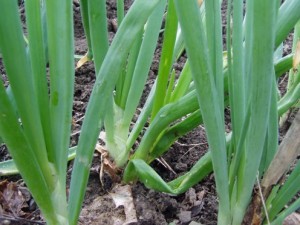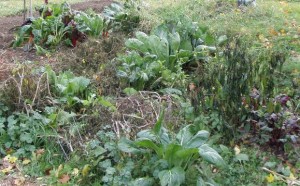 This week was, to certain extent, the ‘last hurrah’ for the garden here at Chez Siberia. We had several ‘killing frosts’ here – this is the sort of frost where basically it coats all the grass in whiteness and crunches when you walk on it. It also will literally melt everything that is not hardy to a certain extent — it explodes the water in the plant cells of plants such as tomatoes, peppers, squashes, non-hardy greens and so on. (more…)
This week was, to certain extent, the ‘last hurrah’ for the garden here at Chez Siberia. We had several ‘killing frosts’ here – this is the sort of frost where basically it coats all the grass in whiteness and crunches when you walk on it. It also will literally melt everything that is not hardy to a certain extent — it explodes the water in the plant cells of plants such as tomatoes, peppers, squashes, non-hardy greens and so on. (more…)
Raising It
Fall Gardening: Evaluating how things went
We interrupt this raincoat for a tomato
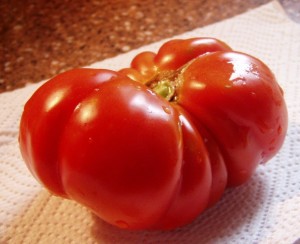 For folks who have arrived, hoping that this is actually ‘The Further Adventures of a Zip-out Lining,” my apologies. Other things have gotten in the way, so you get this, a humble review of how to save tomato seeds.
For folks who have arrived, hoping that this is actually ‘The Further Adventures of a Zip-out Lining,” my apologies. Other things have gotten in the way, so you get this, a humble review of how to save tomato seeds.
Now, the picture up at the top is of a tomato, a very lovely tomato which originates from Russia. Do NOT ask me the name of this tomato because the rest of the seeds which I originally bought have been dispersed amongst other adventurous gardeners in the US (because Aunt Toby is like that) and one of those people got the actual original package. I know. Moronic, right? (more…)
Timely suggestions
OK, folks, sometimes it is good to, as they say in the classical music biz, ‘recapitulate the theme’ before we go on to the ‘variations.’ In your Aunty’s case this weekend, it hit me (literally; the calendar fell off the fridge) that we are now half-way through August, which means many things to many families:
1. School will be starting soon and many of you will be head-first in those lists that get sent out from schools for what your child is expected to have with them when they go back (if they have not gone back already – some school districts have started I think).
2. Even though it is still warm (and still very warm) in many places (except for our readers in Australia and NZ who are moving into the spring), fall and winter are making their inevitable march.
So, as I seem to do every August, your dear Old Aunty is here today to remind you of a couple of things which may be useful in terms of the next 8 weeks or so (depending on where you live):
First, it is still warm, which means that we have a window of opportunity (as they say) to use substances such as caulk, paint, wood putty and so on, which require temperatures of at least 55 degrees F to cure.
Second, if you have been cudgeling yourselves over the head with doing something about making your home more energy efficient, now is a bloody good time to actually take steps to doing it. There is literally nothing worse than laying on your back in a crawl space in December putting in insulation (well, actually, there IS something worse and that is laying on your back on a filthy barn floor when it’s 0 degrees F. at 2 a.m. and trying to help a ewe have her lambs. But we don’t do that anymore, hey nonnie nonnie and a fiddle-dee-dee). Doing this in August, September or October is much less nasty.
If you’ve been thinking about getting into canning or freezing (even if you don’t have a garden yourself), now as as good a time as any to do this. First – the farmers markets are exploding with gorgeous produce and so-called ‘U pick” is humming out there with fruits and veggies. Check with your county Cooperative Extension to see if they are having any canning, freezing, jam making etc. sorts of classes.
Let’s say you do have a freezer – now is a very good time to check it out and bring all the older stuff (you DO label what you put in there with what it is and when you put it in, right?) to the top or the front (depending on what sort of freezer you have) so that you can use it up before winter starts.
If you have a garden or beds or planters of plants, you may look out and feel that all the flowers are looking just a tad peaked at this point. Deadhead the perennials and cut back the annuals and give everything a good dose of organic fertilizer like compost tea or fish emulsion in water. That should give them a good pick-me-up to carry them into the fall.
For those folks looking for some posts to help them along, here you go:
Saving Energy
http://www.kitchencountereconomics.com/2012/01/07/saving-energy-basement-windows/
http://www.kitchencountereconomics.com/2011/09/03/its-that-time-of-the-year/
http://www.kitchencountereconomics.com/2010/08/12/55-keep-your-eyes-on-the-thermometer/
http://www.kitchencountereconomics.com/2009/10/08/to-do-list-caulk-now/
http://www.kitchencountereconomics.com/2011/12/17/give-the-gift-of-warm-feet-part-1/
http://www.kitchencountereconomics.com/2011/12/18/the-gift-of-warm-feet-part-2-fiberglass/
Freezing, Canning
http://www.kitchencountereconomics.com/2010/08/22/overwhelmed-with-tomatoes/
http://www.kitchencountereconomics.com/2009/05/30/introduction-to-canning/
http://www.kitchencountereconomics.com/2009/05/28/be-prepared-introduction-to-anxiety-part-one/
http://www.kitchencountereconomics.com/2009/08/02/wmd-zucchini-time/
http://www.kitchencountereconomics.com/2009/06/01/the-exploding-pressure-canner-and-other-kitchen-myths/
Enjoy!
Stalking the Wild Spaghetti Squash
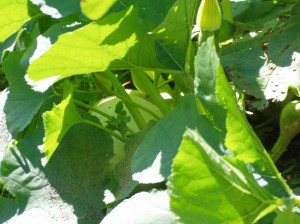 Shhhhhhhh. We’ve now encountered the elusive spaghetti squash in her native habitat. If you look carefully, you can see her crouching here, under the large spiny leaves toward the back. (more…)
Shhhhhhhh. We’ve now encountered the elusive spaghetti squash in her native habitat. If you look carefully, you can see her crouching here, under the large spiny leaves toward the back. (more…)
Currant Affair
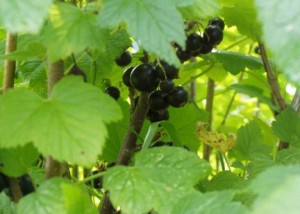 What you see in the photo here are what are referred to as black currants, one of the members of the ribes family (which also includes red and white currants and gooseberries), which are a woody flowering plant native to Central and Northern Europe. Red currants are much much smaller (which makes them tedious to pick) – some of these on our bushes rival reasonably large blueberries in size. Currant root and seeds (and the fruits are really, really seedy) are high in alpha and gamma linoleic acid. Currants themselves are very high in Vit. C and have high levels of phytochemicals which have shown anti-inflammatory properties. (more…)
What you see in the photo here are what are referred to as black currants, one of the members of the ribes family (which also includes red and white currants and gooseberries), which are a woody flowering plant native to Central and Northern Europe. Red currants are much much smaller (which makes them tedious to pick) – some of these on our bushes rival reasonably large blueberries in size. Currant root and seeds (and the fruits are really, really seedy) are high in alpha and gamma linoleic acid. Currants themselves are very high in Vit. C and have high levels of phytochemicals which have shown anti-inflammatory properties. (more…)
Chicken Tractor into… something else
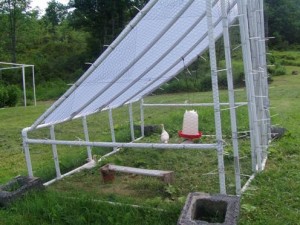 Remember this structure? This is our version of a ‘chicken tractor’, those moveable bird shelters which those of us who raise chickens (and in this case, mini turkeys) out on pasture. They are very useful things indeed and we made ours out of pvc pipe because of the size and weight issues. Now, PVC will not last forever under the stress of temperature changes and the sun, but these tractors have given us good service for at least 4 years, so that gives you an estimate of life so far.
Remember this structure? This is our version of a ‘chicken tractor’, those moveable bird shelters which those of us who raise chickens (and in this case, mini turkeys) out on pasture. They are very useful things indeed and we made ours out of pvc pipe because of the size and weight issues. Now, PVC will not last forever under the stress of temperature changes and the sun, but these tractors have given us good service for at least 4 years, so that gives you an estimate of life so far.
We are not raising so many birds now and we have a different issue. A couple of years ago, we planted current bushes up on the hill and they are finally bearing fruit.
And the birds like it, too.
So, this year, we decided to fool them. The DH took apart two of the chicken tractors (we did not glue together the PVC pipe so that we could do this; it made the tractors a bit ‘flexy’, but gave us the opportunity to turn them into something else if need be…which it needed to be) and reconfigured them into this structure here.
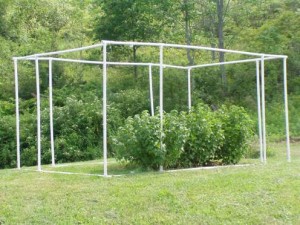 So far, this doesn’t look like much of a bird deterrent, does it?
So far, this doesn’t look like much of a bird deterrent, does it?
Well, first, we are going to move it a little bit (the DH was mowing yesterday, so he moved it to get closer to the bushes) so that the bushes are in the center and then we are going to cover the structure with bird netting. What is bird netting? Bird Netting As you can see from the link, this is a small-holed plastic netting which is laid over crops such as strawberries or fruit trees and bushes. We will encase the structure in that so that the birds will have to go find their fruit elsewhere. We have plenty of other sources here at Chez Siberia for them in the form of the various ornamental cherry and shad trees on the property. They are more than welcome to that.
Seedlings Will Not Wait
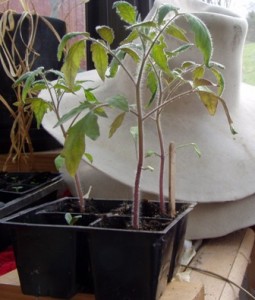 There is one fact about starting seedlings early yourself – sometimes no matter what you do, they just take off and there you are, more than a month before you can even think about putting them into the ground (and at Chez Siberia, we’re talking probably 5 weeks from now unless I decide to throw caution to the winds), and the seedlings have outgrown their packs and hoo-wee, what are we going to do now?
There is one fact about starting seedlings early yourself – sometimes no matter what you do, they just take off and there you are, more than a month before you can even think about putting them into the ground (and at Chez Siberia, we’re talking probably 5 weeks from now unless I decide to throw caution to the winds), and the seedlings have outgrown their packs and hoo-wee, what are we going to do now?
Well, your Aunt Toby, over the past (ahem, well, let’s note get into how long, shall we?).. well, we’ve tried a whole lot of different methods here at Chez Siberia, to hold over tomato seedlings until ‘more auspicious times’. In the old days, when I could get waxed paper milk cartons, I’d sink them into those (and we also at that time had three Little Siberians, so we went through a lot of milk). These days, I’m just using pots, but if you have a source of waxed paper cartons (juice will also do; just make sure you rinse them out really well and punch a couple of drainage holes in the bottom. The secret is to match the size of the pot or carton to the length of the seedling above the level of the dirt.
You are going to — mwa-ha-ha — bury them.
So, take your carton and hold it up against the seedling and mark the top of that and cut the top off. if you have appropriate sized pots, then use those.
Using a really good potting mix (if it’s light brown or fluffy, this means that it’s got TOO MUCH PEAT IN IT. So, don’t use that. If you have that already, then add compost and something like vermiculite to hold water), put a small amount in the bottom – an inch will do. Pop the seedling out of the pack and GENTLY crumble the soil at the root level. You want to free up those roots. Then carefully take off the bottom set of leaves (trust me on this one) and put the seedling into the carton or pot.
Put in some potting mix around the bottom of the seedling and firm down well. Then holding up the seedling with your other hand, fill in the rest of the pot. 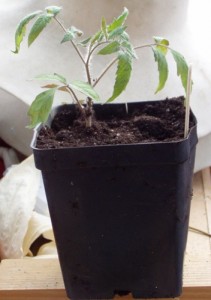 Your tomato seedling should be just showing the regular leaves now and the plant will form roots all along the stem under the dirt. When it’s time to plant it out, just dig a deeper hole than usual.
Your tomato seedling should be just showing the regular leaves now and the plant will form roots all along the stem under the dirt. When it’s time to plant it out, just dig a deeper hole than usual.
On and on in the garden
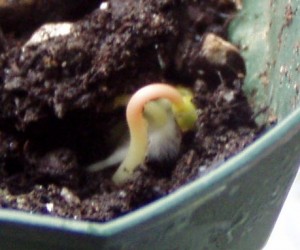 For those of you who are in Zone 5 and higher, my situation really does not fit. I’m sure you’ve been planting out in your gardens for weeks, if not the last month or so. And for those folks in Zone 7 or 8, you are coming to the end of your winter growing season, I’m sure!
For those of you who are in Zone 5 and higher, my situation really does not fit. I’m sure you’ve been planting out in your gardens for weeks, if not the last month or so. And for those folks in Zone 7 or 8, you are coming to the end of your winter growing season, I’m sure!
But, for people like your dear Aunty, who grow in ‘Zone 4 which is really Zone 2’, things are still very chancy, even for cold weather crops. We had a couple of very warm days last weekend, which put the soil temperature way up, but I knew it would not last. Since we were slated to get rain (which we did, day after day after day), I uncovered the beds that I’d put under plastic so that they’d get a good drink and then I covered them back up again to get some solar gain.
Sometimes, people ask me whether putting plastic (or glass as I’ve done before) really is worth it. Well, this morning, after running errands, I went out and took the temperature of the end of the bed that didn’t get covered with the plastic. It was 44.3 degrees F. Too cold to plant anything in. Under the plastic, it was 50.1 degrees F. Marginally ready to put in seeds for plants such as lettuce, cabbage, cauliflower, broccoli, Chinese cabbage and so on. I’ll give it one more week. We’re supposed to have a couple of very sunny days in the low 60-degree range, which should bring that area under the plastic into a solid mid-50 degrees which will be plenty safe for sowing those seeds.
But I’d like you to notice the difference. Not under the plastic: 44.3 degrees F. Under the plastic: 50.1 degrees F. At this point in the spring, that’s a lot of temperature difference so I have to say it is definitely worth it since I’ll be able to put in those seeds now, in April, instead of late May otherwise. So, I’ve gained 6 weeks on my growing season. Definitely worth it.
The photo at the top is of some buckwheat seeds I gave to my grandson to plant in a pot as a little activity this past week. He planted them on Tuesday. I put them into a plastic bag on top of a heating pad covered with an old towel in the green house. That photo was taken on Thursday.
48 hours, some dirt, some moisture and some heat and up they come. But wait until you see the next photo: This photo was taken on Saturday!!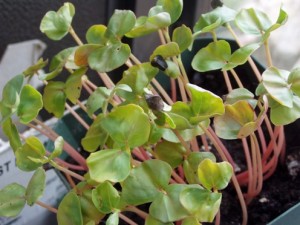 So, there you are – in terms of buckwheat, as long as you’ve got warmth in the soil and some moisture, they are up and running fast, which is the reputation of this plant, since the directions literally tell you that if you are not interested in growing buckwheat for seed (that is, to harvest seed for eating or saving), you need to be cutting it down and digging it into the soil in less than 6 weeks, when it will be flowering. This past week, when we had those sunny days, I sowed one whole bed under the plastic with buckwheat seeds to start the soil improvement process. That bed was created last year and we did not have proper compost to do it. We used compost from the county landfill which frankly was mostly rotted wood chips. It was awful and the tomato plants we put into it showed the lack of soil and lack of nutrients – they frankly crouched on the ground. It was a waste of time to put anything in there. I should have done then what I’m doing this spring – put in buckwheat and when it’s up, cut it down and dig it into the bed, then water well and sow more buckwheat seed. In a couple of months, I’ll have a lot better bed than I do now and I’ll be able to put something else in there in June and July, whether that is a crop of beans, or cabbage family plants for the fall.
So, there you are – in terms of buckwheat, as long as you’ve got warmth in the soil and some moisture, they are up and running fast, which is the reputation of this plant, since the directions literally tell you that if you are not interested in growing buckwheat for seed (that is, to harvest seed for eating or saving), you need to be cutting it down and digging it into the soil in less than 6 weeks, when it will be flowering. This past week, when we had those sunny days, I sowed one whole bed under the plastic with buckwheat seeds to start the soil improvement process. That bed was created last year and we did not have proper compost to do it. We used compost from the county landfill which frankly was mostly rotted wood chips. It was awful and the tomato plants we put into it showed the lack of soil and lack of nutrients – they frankly crouched on the ground. It was a waste of time to put anything in there. I should have done then what I’m doing this spring – put in buckwheat and when it’s up, cut it down and dig it into the bed, then water well and sow more buckwheat seed. In a couple of months, I’ll have a lot better bed than I do now and I’ll be able to put something else in there in June and July, whether that is a crop of beans, or cabbage family plants for the fall.
Let’s see now. In our greenhouse (which is unheated – I use heating mats with grids over them for the seedlings to stay warm inside their huge clear plastic bags), the pepper and tomato seedlings have had to be moved to larger quarters, and I also sowed a flat of a mix of basil seeds I got from Pinetree Seeds Pinetree Garden Seeds. One of the things I especially like about this company (besides the fact that it is locally owned, not part of a conglomerate, and they offer an amazing array of vegetable seeds from all over the world) is that they offer mixes of things. I don’t have that large a garden, so buying three or four different packets of any particular thing is not cost effective for me. But we use basil in cooking a lot, so I grow a lot, and like different types for different reasons, so having a packet of a mix of basil is a great thing for me. They offer mixes of seeds for almost all of their veggies so, if you want to try something new, I recommend you take a look.
Another change this year is that our grandson is now at the age where we can start inculcating (woops – introducing him might be a better word) him about the wonders of gardening (hence the handful of buckwheat seeds in the pot of soil). I showed him a seed catalog and we went through it, identifying the various vegetables and talking about what he’d like to grow in ‘his’ garden – I figure one little 3-4 foot end of a bed will work for one tomato plant, one pepper plant, a marigold (got to have flowers in every garden, right?) and a handful of beans. I always feel that little kids get some of their best introductions to new veggies when they are in the garden and can pick, snip and pull them up by themselves. Who knows, perhaps he’ll learn to like kohlrabi and parsnips this year?
Gardening when it’s too cold to garden
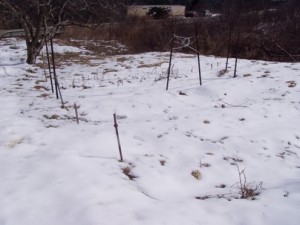 Anyone who knows me will tell you that I am one impatient gardener. Last year, we got lucky and by this time, it had been in the 60s for several weeks. No such luck this year. The photo at the top was taken about a week ago. faced with a garden covered in snow and wanting to get things started, I know only one way to jumpstart the soil- warming process.
Anyone who knows me will tell you that I am one impatient gardener. Last year, we got lucky and by this time, it had been in the 60s for several weeks. No such luck this year. The photo at the top was taken about a week ago. faced with a garden covered in snow and wanting to get things started, I know only one way to jumpstart the soil- warming process.
Shoveling.
Yes, I literally took out my show shovel and scraped off as much of the snow off one of the garden beds as I could. And it looked like this: 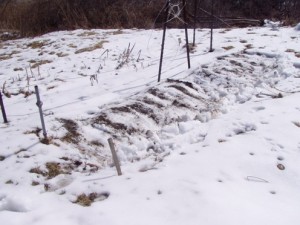 The ground was frozen solid so there was no way to get anymore of that off without removing actual soil from the bed. But the thing is this: Once you’ve taken the top layer of the snow off, if there is any sun or warmth at all, the rest will melt off. and then you have dark soil. And if there is any sun at all, that will start to warm up.
The ground was frozen solid so there was no way to get anymore of that off without removing actual soil from the bed. But the thing is this: Once you’ve taken the top layer of the snow off, if there is any sun or warmth at all, the rest will melt off. and then you have dark soil. And if there is any sun at all, that will start to warm up.
I’m not kidding you. Literally within a couple of days, not only was everything melted off that bed, with the other beds to follow, but the soil in that particular bed was up to 39 degrees F. From ‘frozen solid’ to 39 degrees. And that is without any help from glass or plastic (which I put out this weekend since we are slated to have a sunny week this week. I’m pushing hard to get that bed up to 50 degrees so that I can put in seeds for lettuce, cabbage, broccoli, chard, beets and other cold-hardy crops. I’m just itching to get out there but just can’t until that soil warms up.
Other activities which keep me from going bonkers about not being able to get out and put my hands in the soil are starting seeds. About two weeks ago, I started various tomatoes (including seeds from a paste tomato that I saved in 2008 (that is not a typo, folks – tomato seeds under the right conditions (in this case, inside waxed paper inside a ziplock(tm) bag in the fridge door) will stay potent for a long time. And I think every single one of those seeds came up. I was amazed.
Now, I’ve tried all sorts of DIY methods on seed starting, including a wonderful screened table that the DH built for me in the basement where we clipped infrared lights that are used for brooding chicks underneath the screens, but in the end, the trick is:
a) You need a gentle source of heat underneath the soil and
b) You need a humid atmosphere
Once they are germinated, then you need sunlight. They took off so quickly that by the time I got time to transplant them this weekend, they had gotten too big, so I pulled together some 4″ pots and planted the seedlings up to their leaves in soil. Another thing I did, which I also advocate is that I dragged the potting mix out onto the patio into the sun, filled the pots out there and left them there in the sun for most of the day to bring the soil temperature in the bots up to at least 50. That bag of potting mix had been in the garage and it was frankly about 35 degrees. If I’d transplanted into that, I’d have killed or stunted the tomatoes for sure. As it is, they are very happy campers now.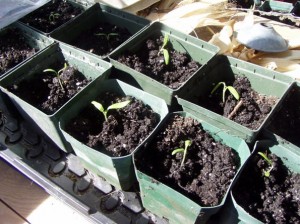 The peppers are not as far along, which is standard, though I’m not sure why peppers should take longer to germinate and take off than tomatoes do, but I have never had an experience where they have not been slow.
The peppers are not as far along, which is standard, though I’m not sure why peppers should take longer to germinate and take off than tomatoes do, but I have never had an experience where they have not been slow.
So, at the moment, I have a couple of garden beds which are now under plastic and hope the sunny days this week will bring them up at least into the 40s. It usually takes a couple of weeks of solid warm weather and sun to raise the soil under glass or plastic into a temperature range where I can feel reasonably secure about putting even cold-weather crop seeds into it. If I had them as seedlings, it would not be as risky, but they are easy enough to plant into the soil if it’s in the 50-degree range.
What are you planting this year? My new vegetable this year is parsnips. I had a wonderful dish of parsnip puree during the winter and I’m willing to give them a shot.
